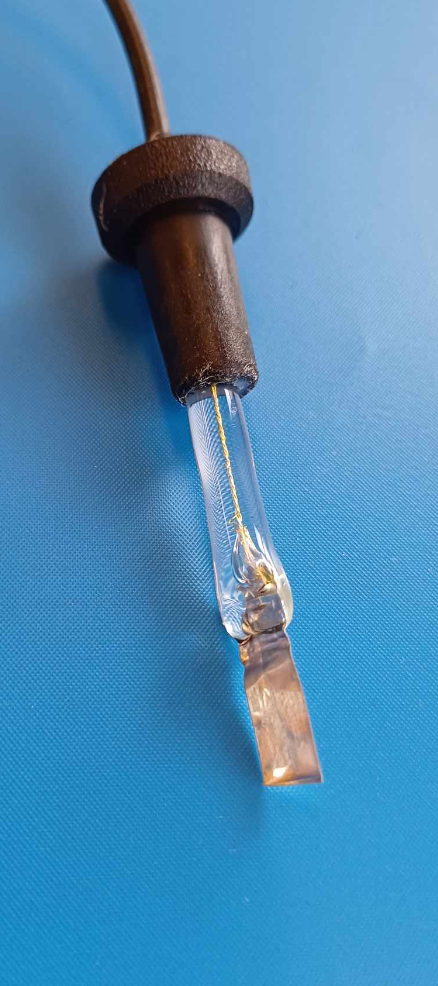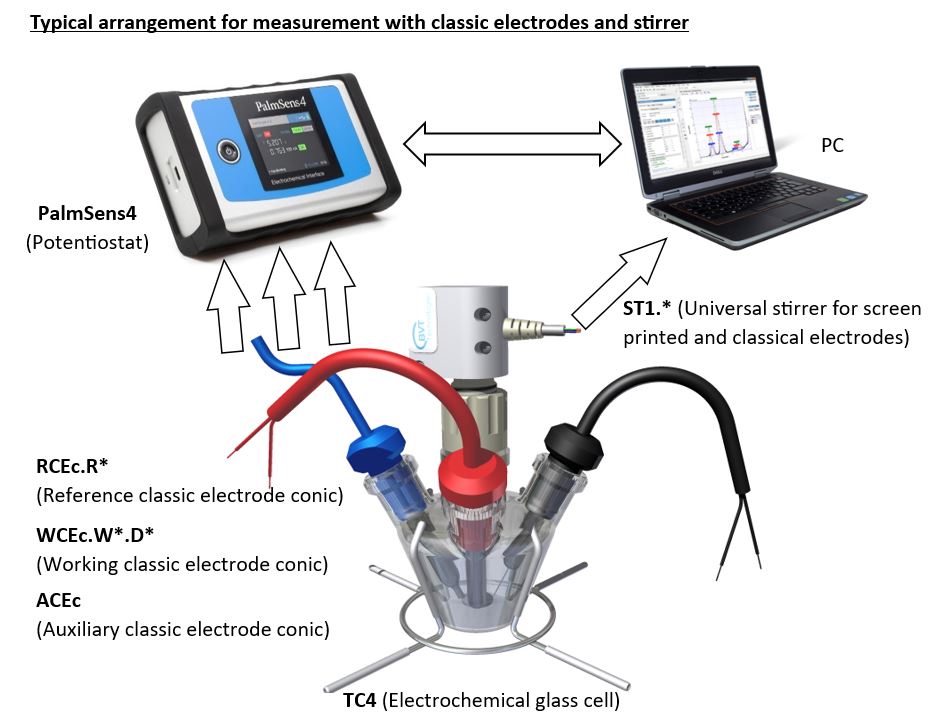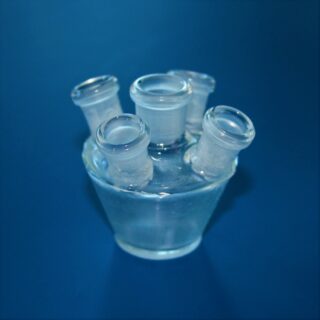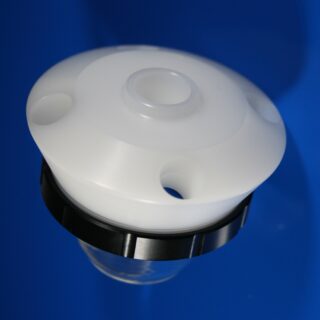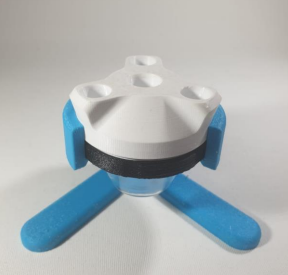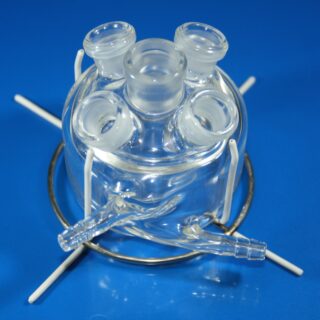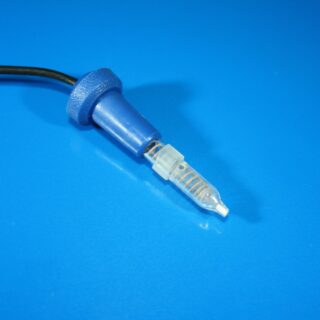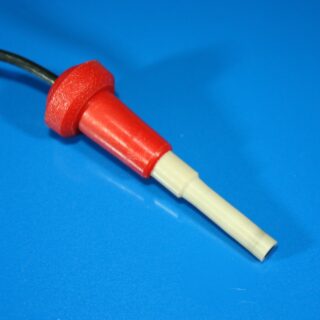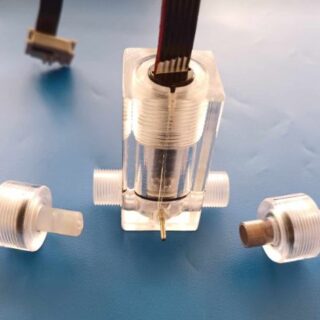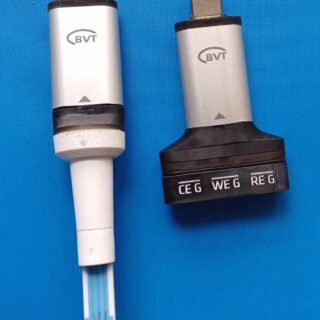Category
- Custom made glass products
- CUSTOMER SERVICES
- NEW PRODUCTS
- Sensors and electrodes
- Custom made and Modified Screen Printed Electrodes
- Stirrers
- Cables and connectors
- Cell
- Potentiostats
- Manual Screen Printer
- Minithermostat
- Pumps
- Accessories
- Kits & Sets
- Discounted SPEs (at a reduced price with visual defects/inconsistancies, but fully functional)
ACEc.Pt plate Auxiliary Classic Electrode Conic with platinum plate
ACEc.Pt plate is a glass tube with platinum plate of guaranteed purity 99.99 %. Standard connection is with a 2 mm banana plug. Auxiliary classic electrode with platinum plate (ACEc.Pt plate) is designed for electrochemical measurements.
Dimensions of Pt plate: 15 x 5 mm Pt
(Pt thickness approx. 0.21 mm)
The size of the platinum sheet can be adjusted at the customer’s request.
You may also like…
-
TC4 Electrochemical Glass Cell
Read moreSimple borosilicate glass cell serves for electrochemical measurements.
The temperature of the analyzed solution can be controlled when placing the cell in MT1-1 minithermostat.
Cell openings are designed for electrochemical sensors connector KA1.C, classical electrodes WCEc, ACEc, RCEc and stirrer ST1, ST3 separately.
-
TC6 Electrochemical Glass Cell
Read moreBorosilicate glass cell serves for electrochemical measurements.
The analyzed solution can be thermostated by minithermostat MT1-1.
Cell openings are designed for electrochemical sensors connector KA1.C, classical electrodes WCEc, ACEc, RCEc and stirrer ST1, ST3 separately.
The device enables the measurement with inserted samples.
-
TC7 Electrochemical Glass Cell
Read moreThe TC7 is a low cost Glass Cell that is ideal for students and basic lab measurements.
The TC7 comes with a stand, specially designed for it, and the stand provides more stability and ease of use.
The Borosilicate glass cell serves for electrochemical measurements. Cell openings are designed for the SPE Electrochemical Sensors Connector KA1.C,Classical Electrodes WCEc, ACEc, RCEc, STP1.*
Stoppers for Cells, and Stirrer’s ST1 and ST3 separately.
The device enables the measurement with inserted samples.
-
TC5 Electrochemical Glass Cell
Read moreBorosilicate glass cell serves for electrochemical measurements. The cell is jacketed.
The analyzed solution can be thermostated by external thermostat.
Cell openings are designed for electrochemical sensors connector KA1.C, classical electrodes WCEc, ACEc, RCEc and stirrer ST1, ST3 separately.
Related products
-
RCEc.R* Reference Classic Electrode Conic
Read moreRCEc is a glass hollow tube with silver or silver covered by silver chloride wire inside. The tube is hollow with the hole in the wall for inserting KCl solution.
Hole is covered by a rubber band. Reference classic electrode (RCEc) is designed for measurements with glass cell TC4, TC5, TC6, TC9.
Standard connection is with a 2 mm banana connector.
Connector or banana plug colour is blue.
-
WCEc.W*.D* Working Classic Electrode Conic
Read moreWCEc is a glass tube with a Pt or Au (wire) or a peek tube with a compact glassy carbon inside.
Only the circle glossy area of the (Pt or Au) metal wire is outside the glass tube or the circular glossy area of compact glassy carbon is outside the plastic peek tube. Standard connection is with a 2 mm banana connector. Connector or banana plug colour is red. Working classic electrode (WCEc) is designed for measurements with TC4, TC5, TC6, TC9 glass cell.
-
FC.1ISE.1REF Flow cell for single ion selective electrode with integrated stirring
Read moreThe flow cell with integrated stirring and reduced hydrodynamic noise is designed for the determination of single analyte using one miniature ion-selective electrode (ISE) and one miniature reference electrode with a diameter of 6 mm and length of 60 mm.
Rotation speed of integrated stirrer: 10-4000 rmp.
Miniature ion-selective electrodes and reference electrode were designed for integration into the flow cell for determination of Cl-, K+, Ca2+ and Na+ ions.
In flow mode, the system can operate automatically. The speed of the integrated stirrer can also be controlled by applying the corresponding voltage to the motor, connected to a stabilized source.
The flow cell with one selected ISE can be used for:
- Automatic or semi-automatic measurement of concentration of Cl-, K+, Ca2+ and Na+ ions in various solutions (following prior calibration)
- For continuous measurement of changes in concentration of Cl-, K+, Ca2+ and Na+ ions.
* For this product, we recommend our customers use the Training Service from BVT.
(https://bvt.cz/produkt/offer-of-long-term-automated-measurements-on-bvt-apparatus/)
-
USB Potentiostat Galvanoplot
Read moreUSB Potentiostat Galvanoplot is a super small, low-cost and affordable device suitable for dedicated volume applications, which is optimized for screen-printed sensor and biosensor applications. It can be used in many other research areas and with other electrochemical sensors, for corrosion measurement, battery and super-capacitors or fuel cells.
It is capable of performing all common Amperometric and Voltammetric electrochemistry protocols (CA, LSV, CV, DPV, NPV, SVW, GAL) and can be used with three electrode (WE/RE/CE) and two electrode (WE/RE-CE) setups. Plug the device directly into an Android mobile device through OTG port for a true on-site analysis experience. It is possible to choose from two types of interfaces allowing direct insertion of the BVT SPE sensors or the use of 3 classical electrodes with 2 mm banana plugs (WE, RE, CE).
Specifications
- Dimensions: 39x17x8 mm
- Weight: 5 g without sensor interface
- Voltage scan range: +-3V @1mV resolution
- Max current: 2000 nA (*at the request of the customer, it is possible to change the range, but this will change the resolution, noise and other parameters)
- Current resolution: 300pA@1KSPS/ 100pA@100SPS/ 30pA/10 SPS resolution
- Noise around: 50nA@1KSPS/ 7nA@100SPS/ 400pA/10 SPS
- Protocols: CA, LSV, CV, DPV, NPV, SVW, GAL
- Cell type: WE/RE/CE and WE/RE-CE
Connectivity: USB-C (Plug the device directly into an Android mobile device through OTG port for a true on-site analysis experience)
- Operating system compatibility: Windows 8, 10+
- Advanced analysis – filtering and auto peaks
Device Usage
- Electrochemical measurements
- Measurements with biosensors and electrochemical sensors
- Measurement of biochemical activity of a sample
- Corrosion measurement

